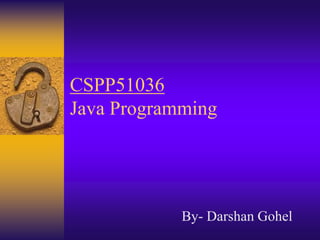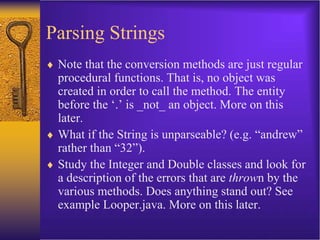Basics java programing
- 2. Who is this class for? There is no assumption that you know any Java or other OO programming language. If you do, you may find the first few weeks boring. You must have programming experience. We will not spend very much time on syntax, procedural constructs, operators, etc. It is assumed that you can pick this up.
- 3. History of Java First version released in 1995 Eight major versions released since then – JDK 1.0 (1996) JDBC, Distributed Objects – JDK 1.1 (1997) New Event Model – J2SE 1.2 (1998) Swing – J2SE 1.3 (2000) Cleanup – J2SE 1.4 (2002) – J2SE 5.0 (2004) Generics – J2SE 6.0 (2006) – J2SE 7.0 (2011)
- 4. Five Design Principles of Java simple, object-oriented and familiar robust and secure architecture-neutral and portable execute with "high performance interpreted, threaded, and dynamic
- 5. What is/isn’t Java? Read chapter 1 of Core Java – Discussion is very balanced Basically, compared to C Java is a relatively high- level language with many built-in features for portably doing useful things such as: – Multithreading – Writing distributed programs – Writing GUI clients – Error handling – Extending Web servers – Embedding programs in Web browsers – Connecting to commercial databases
- 7. Java vs. C Equally importantly, Java has many core language features that make it much more natural to express abstraction, develop software frameworks, etc. Also, many core language features which ease debugging and promote reuse.
- 8. Compiling/running first java program Create source code file (call it for example MyFirstProgram.java). To compile: prompt >> javac MyFirstProgram.java This produces byte code file named MyFirstProgram.class To run: prompt >> java MyFirstProgram
- 9. Observations .class file is not machine code. It is intermediate form called Java Byte code. Can run on any platform as long as platform has a Java Virtual Machine (JVM). The second step on previous slide invokes the JVM to interpret the byte code on the given platform. In theory, byte code can be moved to another platform and be run there without recompiling – this is the magic of applets. Leave off the .class part when invoking the JVM.
- 10. Observations This is an old-fashioned command-line program. Java also supports GUI applications and web-browser hosted programs called applets. After the first couple of weeks we will use graphical rather than scripting front-ends.
- 11. Writing first program To keep things simple our first few programs will all be written as just a single main program. In java, the file in which your program resides must contain a .java extension (e.g. MyFirstProgram.java).
- 12. Writing first program Then, the program must be wrapped in a class definition which is the same as the file basename (MyFirstProgram). Careful, Java is case-sensitive. class MyFirstProgram { … } Finally, main is defined similar to C, but with a few more modifiers: public static void main(String[] args){ … } These are all required. No shortcuts.
- 13. Writing first program Just as in C, main(..) is the principle entry point into the program. When you say java Program Java looks in Program for a procedure named main. This is where the program starts. To print to stdout in java use: System.out.println(“ …”); MyFirstProgram.
- 14. Basic Programming Constructs What you should learn on your own
- 15. Breakdown of a java program Strategy to start is write evertything in a single main program and very quickly review the basics of java syntax (very little time here). Then we break into procedures. Then class/packages.
- 16. Single-threaded program For a single thread of execution, each line of code is executed sequentially (as in C). Each statement is terminated with a semicolon. Unlike C, declarations can occur anywhere within a program. Basic operators, control statements almost exactly like C. A few minor differences. Best to just look at some examples.
- 17. Java Data Types Sizes fully specified by Java standard. Java is a very strongly typed language Integer types – int (4 bytes signed) – short (2 bytes signed) – long (8 bytes signed) use suffix L (eg 1000000000L) – byte (1 byte signed) Floating-point types – float (4 bytes) use suffix F (eg 1.28F) – double( 8 bytes)
- 18. Additional Data Types char – Two-byte unicode – Assignment with ‘ ‘ • e.g. char c = ‘h’; boolean – true or false e.g. boolean x = true; if (x){…};
- 19. Operators/Control Flow Almost exactly like regular ANSI C. +, *, -, /, %, ++, --, +=, etc. ==, !=, >, < , etc. if statements, for loops, while loops, do loops, switch statements, etc. continue, break, return, System.exit(0). Read pp 54– in Core Java. No need to spend class time going over these.
- 20. Scoping Braces are used as in C to denote begin/end of blocks Be careful of the following: int j = 0; if ( j <1 ){ int k = 2; … } k = 3; //Error! k inaccessible here Declarations do not propogate upwards.
- 21. Adding datatypes -- classes Java has handful of built-in datatypes just discussed (int, float, etc.) Just like in C, user typically creates own homemade datatypes to work with particular application (ie structs and enums). In Java these are called classes. Many class definitions come as a standard part of the Java distribution. Most common Example is String class.
- 22. Strings Java provides a class definition for a type called String Since the String class is part of the java.lang package, no special imports are required to use it (like a header file in C). Just like regular datatypes (and like C), variables of type String are declared as: String s1; String s2, s3; //etc. Note that String is uppercase. This is the Java convention for classnames.
- 23. Strings Initializing a String is painless s1 = “This is some java String”; Note that double quotes are required. Memory is allocated dynamically. Think of above method as shortcut for more standard way (assuming s1 has been declared): s1 = new String(“This is some java String”); new operator required to create memory for new String object.
- 24. String methods Given a String object we can then access any public String method or instance variable (field). Best to think of analogy with C. Given a variable of some struct type, we can access any of the struct’s members. If one of these members is a pointer to a function, we can essentially call a function using the struct. (x.doit(x,…)) In Java, this idea is taken quite a bit further, but the above analogy is a good start.
- 25. String Examples Best to see by way of example: String s = new String(“Hello”); Char c = s.charAt(3); System.out.println(c); Method charAt called on String object s taking single integer parameter. How might this look in a procedural language with structures? (homework)
- 26. String class documentation Incredibly important! – Each standard java class definition is fully documented online – You must become facile at reading/interpreting these documents. This is how everything is done in Java. – A little hard at first but then very simple. Makes learning new functionality much easier (if it’s well written). – Make a link to http://java.sun.com/j2se/1.3/docs/api/index.html Much of homework will come from interpreting this page.
- 27. 1d Arrays Arrays in Java are dynamic; they are allocated with the new operator. Creating a (1d) array is a two-step process: int[] x; //declare x to be an array of ints //x has the value of null right now x = new int[100]; //allocate 100 ints worth At this point the values of x are all zeroes. Assignment is then just like C.
- 28. 1d Arrays Note that in Java, unlike C, the compiler will not let you overrun the bounds of an array. Give it a try. Note that you must use the new operator to size the array. It cannot be done statically as in C. Until this is done, the array reference has a value of null. The array comes with a field called length which stores the number of elements in the array. Try printing x.length in the previous example. This is a simple but nice convenience.
- 29. Misc tricks to get work done
- 30. Parsings Strings Recall that the args array is an array of Strings. Thus, to accept key input as integers, float, etc. we must convert. To convert to int, use the Integer.parseInt(String) function. Ex. String s1 = “32”; int j = Integer.parseInt(s1); // j now holds 32 Converting to double is analogous: Ex. String s1 = “32”; double j = Double.parseDouble(s1); // j now holds 32
- 31. Parsing Strings Note that the conversion methods are just regular procedural functions. That is, no object was created in order to call the method. The entity before the ‘.’ is _not_ an object. More on this later. What if the String is unparseable? (e.g. “andrew” rather than “32”). Study the Integer and Double classes and look for a description of the errors that are thrown by the various methods. Does anything stand out? See example Looper.java. More on this later.
- 32. Reading Keyboard input at runtime How do we prompt for keyboard input at runtime? Use java.io.Scanner class with standard input stream. Scanner in = new Scanner(System.in); while (in.hasNext()){ String arg = in.next(); }
- 33. Thank you












![Writing first program
Then, the program must be wrapped in a
class definition which is the same as the file
basename (MyFirstProgram). Careful, Java
is case-sensitive.
class MyFirstProgram { … }
Finally, main is defined similar to C, but
with a few more modifiers:
public static void main(String[] args){ … }
These are all required. No shortcuts.](https://image.slidesharecdn.com/basicsjavaprograming-200727104313/85/Basics-java-programing-12-320.jpg)














![1d Arrays
Arrays in Java are dynamic; they are
allocated with the new operator.
Creating a (1d) array is a two-step process:
int[] x; //declare x to be an array of ints
//x has the value of null right now
x = new int[100]; //allocate 100 ints worth
At this point the values of x are all zeroes.
Assignment is then just like C.](https://image.slidesharecdn.com/basicsjavaprograming-200727104313/85/Basics-java-programing-27-320.jpg)





